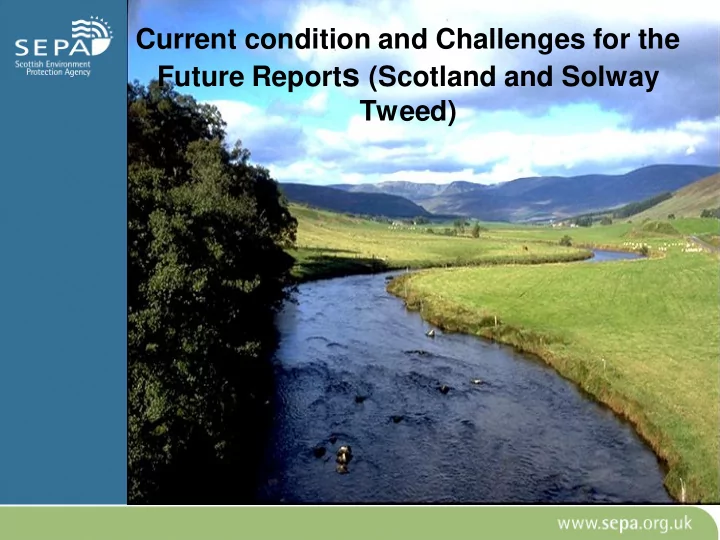

Current condition and Challenges for the Future Report s (Scotland and Solway Tweed)
Where are we in the process? Measures reports AAG meetings
Current condition and challenges for the future Update of characterisation – what is our environment like? Risk 2015 targets – will we get there? What are the significant water management issues for the second plans? Economic Analysis Future challenges to 2050 Consultation on second plans Second plans
Value of the water environment Provision of goods Regulating pollutants Recreation and culture Supporting life
Assessing our progress on improvement targets Water Quality Flows and Levels Physical condition Invasive non-native species
Water Quality Risk Assessment 11% 3% Status good or better in 2% 2009 Planned improvements are on track for 2015 Planned improvements are not currently on track for 83% 2015 Planned to be improved beyond 2015
Analysis of water quality targets 2015 Other On track to tackle pressure by 2015 Rural diffuse pollution Not currently on track to tackle Point Source pollution - pressure by 2015 sewage discharges 0 50 100 150
Water Resources Risk Assessment 10% 0.5% 0.3% Status of good or better in 2.2% 2009 Planned improvements are on track for 2015 Planned improvements are not currently on track for 2015 Post-2015 improvement target has been brought forward to 86% 2015 Planned to be improved beyond 2015
Sector analysis of water resources targets 2015 Other Mining Distilling Public water supply Hydropower Irrigation 0 5 10 15 20 25 30 35 Water bodies where on track to tackle pressure by 2015 Water bodies where not currently on track to tackle pressure by 2015 Water bodies where improvements have been brought forward to 2015
Risk of Deterioration for INNS Source of impact Species Number of surface water bodies at risk of deterioration by 2027 Marine INNS All 47 Colonial Tunicate ( Didemnum vexillum ) 19 Common Cord-grass ( Spartina anglica ) 8 Leathery Sea Squirt ( Styela clava ) 40 Freshwater INNS All 105 Australian Swamp Stonecrop ( Crassula 2 helmsii ) Riparian Vegetation 1 15 North American Signal Crayfish 88 ( Pacifastacus leniusculus ) 1 Includes Giant Hogweed ( Heracleum mantegazzianum ), Japanese Knotweed ( Fallopia japonica ), Rhododendron ( Rhododendron ponticum ) and Himalayan Balsam ( Impatiens glandulifera ).
Identifying key management challenges
Management challenges requiring a step change Diffuse pollution from agriculture Physical condition Toxic substances and urban diffuse pollution Contaminated land issues Invasive non-native species Scope to comment on management options
Rural Diffuse Pollution Progress Priority Catchments 5,600 km rivers surveyed 1,270 farms visited 75% visited farms making positive changes Challenge More numerous and widespread than originally thought Many improvements to do over next cycles Engagement process taking time Need to establish baseline compliance and consider additional targeted measures Options Increase resources for working with sector (Land mangers) Re-prioritise and target funding Work to eliminate phosphorus in livestock feed Build on current training and education provision
Physical Condition Progress Significant on-the-ground improvements delivered, particularly to fish barriers Developed restoration strategy Work with RAFTS to develop strategic approach to barrier removal Partnership projects delivered Challenges Developing voluntary partnerships lengthy process Targeting restoration work where planned is challenging Options Prioritise efforts where there are multiple benefit opportunities, working with other responsible authorities Expand efforts to build partnerships to deliver improvements
Toxic substances and urban diffuse pollution Evidence Small number of water bodies failing for toxics new standards and new substances Focus on “Cessation” Ubiquitous and long lasting Progress in developing understanding UKWIR Chemicals Investigation Programme SEPA Monitoring Emissions Inventory Challenges Proposed EQS more stringent – further breaches likely Compliance with cessation/reduction objective will be extremely challenging for ubiquitous substances Options Diffuse pollution: mechanisms to prevent entry e.g. more SUDS Improved understanding to target where highest loads occur Work with Scottish Water to mitigate from point sources (source control where end of pipe is very costly)
Water pollution from land contamination Evidence Difficult to identify Risks are underestimated Challenges Local Authority resources constrained for contaminated land Options Improved policy framework to better deal with contaminated land affecting groundwater according to environmental risk Identifying clear priorities for action through RBMP
Invasive non-native species Evidence High risk of deterioration Concerns over new species Climate change implications Progress Working with water users in a small number of catchments to control spread Challenges No successful eradication of INNS from marine environment and unlikely in freshwaters Prohibitive cost Will take time to demonstrate effectiveness of strategies Options More resources to focus on a greater number of catchments Tackling pathways to prevent arrival of INNS Promotion of biosecurity measures Eradication where control is successful
Consultation Aims • Indication of support on challenges • Feedback on management options
Key Messages • Regulatory regime is achieving improvements • Need a step change for land use issues such as diffuse agricultural pollution and changes to physical condition, others such as contaminated land, INNS and toxic pollution • Partnership approach key to meeting challenges • Need to further develop our management options with partners and target our efforts
Recommend
More recommend